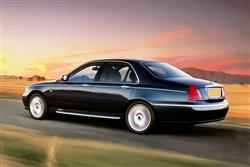THE ENGLISH PATIENT (some text hidden) --NONE--
BY ANDY ENRIGHT
Introductionword count: 89
Rover has produced so many 'last chance saloons' that by now they've become rather good at it. The 75 range is the product of Rover's disastrous spell under the governance of BMW, and if you were expecting the car's abilities to mirror the organisational fiasco that overwhelmed Rover, you'd be quite wrong. The 75 is arguably the best Rover model to date, ruthlessly aimed at a specific target audience and offering good value. As a used proposition, the 75 fares well, with high demand despite fairly strong resale values.
Modelsword count: 21
Models Covered: (4 dr saloon, 5 door Tourer 1.8, 2.0, 2.5, 4.6 petrol 2.0 diesel [Classic (SE), Connoisseur (SE), Club (SE)])
Historyword count: 210
The Rover 75 was a key vehicle for Rover, replacing as it did the 600 and 800 ranges. Launched in February 1999 to massive international acclaim, the 75 surprised many with its rather quaint detailing and uncanny refinement. The range was reasonably straightforward for buyers to comprehend. Three petrol engines and a diesel engine were available in three main trim levels with the basic Classic and SE luxury variant of each added in October 1999. The engines included the trusty Rover K Series 1.8-litre four-cylinder unit as seen in the MGF, Land Rover Freelander and Lotus Elise, and two V6 engines in 2.0-litre and 2.5-litre guises. A 2.0-litre turbo diesel engine was also offered, and the Tourer estate version was introduced in summer 2001. A turbocharged version of the 1.8T engine was introduced in 2002 to replace the thirsty and inefficient 2.0-litre V6 but the biggest change to the range came in early 2004 when the 75 was treated to a controversial facelift. Directly thereafter a V8 version was added, using the same 260bhp 4.6-litre Mustang-sourced engine as the MG ZT 260 and shortly after that an extended wheelbase limousine model was launched. The 75 joined the choir invisible in 2005 as MG Rover sadly departed from volume car production.
What You Getword count: 448
The Rover 75 was created to 'give owners that special sense of occasion every time they use it.' Most will agree that it does. On paper, it competes against cars like Audi's A4, BMW's 3 Series, Saab's 9-3, Mercedes' C-class and Alfa Romeo's 156. In the metal, however, it's a different story. Set a 75 alongside any of these and it seems a classier proposition altogether. So much so in fact that you'd think it competed in the next class up against BMW 5 Series and Audi A6 opposition. This is entirely intentional, of course, for the 75 must, at a stroke, replace not one but two complete ranges - the 600 and 800 Series line-ups. In order to do so, there's an impressive range of engines on offer including a diesel unit courtesy of BMW's 2.0-litre 'Common Rail' unit, the same as that used in the Bavarian company's 320d. Developing 116bhp, the marketeers hope that the 2.0 CDT models will convert diesel doubters, combining as they do sparkling performance (0-60mph in 11.0s en route to 120mph) with an achievable consumption average not far off 50mpg. The V6s aren't the fastest engines of their kind, but they're certainly among the most refined. However, they produce a lovely six-cylinder burble that really will put Rover enthusiasts in mind of some of the classic models from the '40s and '50s. The same is true of the interior, complete with its oval 'steam engine' binnacle dials that look like they've been lifted from one of HG Wells' time machines. Other lovely detail touches also take you back: the chrome-plated door pulls and wing mirrors, the satisfying 'clunk' as the doors shut - even the wood fascia, designed into the cabin rather than added on as an afterthought. It isn't really wood of course, but who cares? It's the ambience that matters and ambience is something the 75 has in abundance. Accommodation is one area where those glorious 'junior Bentley' looks flatter to deceive. The 75 may be somewhere between a 3 and a 5 Series in exterior length but inside, there's no more room than you'd find in the smaller 'Three'. This is surprising when you consider the natural packaging advantages that the front wheel drive Rover enjoys over its rear wheel drive German counterparts. In compensation, the boot is a reasonable size - though you have to pay extra for a folding rear seat. Standard equipment levels really depend upon the size of your chequebook and your choice between three main trim levels - Classic, Club and Connoisseur. Either way, however, expect to find ABS, powered front windows and mirrors, a six-speaker stereo and an alarm fitted across the range.
To see the full road test text contact us on 0330 0020 227
Pictures (high res disabled)


|

|

| |||

|

|

| |||

|

|

| |||

|

|
Scoring (subset of scores)
Category: Luxury Saloons and Estates
| Performance | |
| Handling | |
| Comfort | |
| Space | |
| Styling, Build, Value, Equipment, Depreciation, Handling, Insurance and Total scores are available with our full data feed. | |



